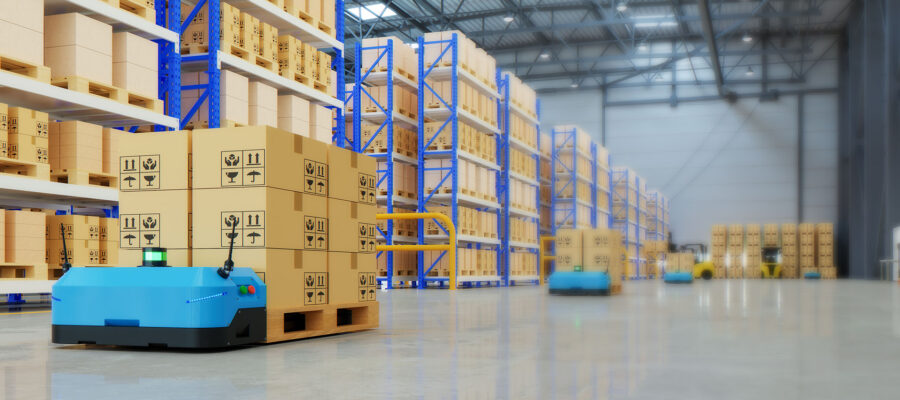This post has already been read 28485 times!
Technology is transforming the supply chain with new advancements that could help mitigate the global supply chain crisis.
The supply chain has been under excessive strain since 2020, from the pandemic response, and now further burdened by the crisis in the Ukraine, Israel, and Europe. Meanwhile, public demand for goods continues to rise.
Supply chain technology is helping address many of the issues behind the supply chain crisis. These innovations make the system more resilient and offer additional benefits, such as speeding up the flow of good, reducing costs, and minimizing waste and emissions. Artificial intelligence in particular, in its various forms, machine learning, large language models (LLMs), and generative pre-trained transformers (GPT), are informing a wide range of technologies from autonomous vehicles and drones to supply chain management platforms. Lets take a look at the most promising technologies that are driving improved supply chain performance.
1. Autonomous Vehicles
Self-driving vehicles could drastically improve supply chain efficiency, especially given today’s widespread labor shortage. Driverless cars and trucks are inching closer to mainstream use. For example, autonomous semi-truck company TuSimple conducted a groundbreaking test of its driverless tractor-trailer on an 80-mile stretch of public highway in late 2021. The truck safely completed its route with zero human intervention.
To put the value of this kind of vehicle in perspective, the U.S. is currently short an estimated 80,000 truck drivers. Goods could be transported through domestic supply chains much more efficiently with driverless trucks to fill in the gaps. They are expected to reduce emissions, as well, since the vehicle’s AI can precisely minimize fuel consumption.
With a major truck driver shortfall of 80,000, could driverless trucks get a boost? | 6 Ways Technology Makes the Supply Chain More Efficient #ArtificialIntelligence #Robotics Share on XMany experts predict that autonomous vehicles will lead to safer roads, by reducing the number of crashes and fatalities on the road. Studies show that over 90 percent of crashes are due to some level of human error. Reducing this figure even modestly, would save a significant number of lives and make our roads much safer.
In short, autonomous trucks could create a supply chain that is faster, safer, and uses fewer workers and less fuel.

2. Drone Deliveries
Drones could be particularly useful for last-mile efficiency in the supply chain. In fact, Amazon has become famous already for pitching this very idea, with organizations like UPS and Domino’s Pizza following suit. Conceptually, delivery drones would autonomously carry packages from local distribution centers to their final destinations.
These plans could dramatically increase the supply chain’s last-mile efficiency if they come to fruition. Delivery trucks must contend with traffic, indirect routes, numerous stops and drivers’ availability. In contrast, a drone could fly directly to its destination in the absolute shortest path since roads and traffic aren’t problems in the air.
Some level of logistical management and regulations would be needed, but leaders in this space are already considering these issues. Amazon collaborated with the Federal Aviation Administration to get official approval for its delivery drones.
3. Optimizing Delivery Routes
Logistics technology has advanced considerably over the past several years and is making a big difference in the supply chain. One of the challenges of optimizing a supply chain is its sheer complexity, especially once finished products need to be shipped to their destinations. Technology lets manufacturers select optimal transportation modes, delivery routes, and track fuel consumption, to make the most out of every drop of fuel.
"Optimizing mode and route selection, tracking fuel consumption, just some of the ways technology is making supply chains more efficient." -Emily Newton @ReadRevMag #SupplyChain #Logistics Share on XThis was one of the earliest ways technology improved sustainability in the supply chain, as well. Telematics can play a big role here. UPS has been using specialized telematics software to track fuel consumption for years. Things have only improved with advancements like the Internet of Things (IoT) and next-generation logistics and simulation software. These digital tools help companies identify the most efficient delivery routes and find ways to get more packages on the road with fewer trucks. Vehicles are using less fuel and generating fewer emissions due to more efficient operations thanks to this technology.

4. AI and Process Automation
AI and automation are going a long way toward helping manufacturers and suppliers improve their sustainability practices. One of the benefits is that they yield great results for businesses. For example, automation can cut waste by reducing human error due to wasted materials and time. The production process becomes streamlined and precise since robotic cells can perform the same action repeatedly. Fewer accidents occur, reducing costs for businesses and improving their finished products while producing more units in less time.
AI can be used for everything from performance tracking to quality control. Sensors and cameras allow AI to rapidly scan units as they pass through the manufacturing process, catching defective items. Software can help companies identify where they are using resources inefficiently, from materials to energy. Digital twins and simulations, modeling and data analysis can all be enhanced with AI to optimize the supply chain as much as possible.
5. Additive Manufacturing
3D printing products is not possible in every supply chain, but it is highly beneficial for businesses that can utilize it. This technology is also known as additive manufacturing, and it is more versatile than many realize. 3D printing ensures that only the precise amount of material needed for an object is used, reducing waste.
A 3D printer also automates the manufacturing process, optimizing the use of time and materials even further. Today’s machines can print with everything from plastic to metal to concrete, often in remarkably short periods.
Streamlining the use of resources is key to improving supply chain sustainability, as well. Waste and the processes used to dispose of it are major contributors to global greenhouse gas emissions. One way manufacturers can reduce the amount of trash produced in the supply chain is by adopting additive manufacturing.
6. Warehouse Robotics
Warehouses are a critical link in the supply chain, one that can either grind things to a halt or provide an invaluable boost. Robotics help facilities worldwide keep the supply chain moving at top-notch speeds by improving warehouse operating efficiency.
There is no shortage of warehouse robots, from autonomous mobile robots (AMR), rack-climbing pick-and-put-away robots, to cobots.
Interestingly, the supply chain has seen significant growth in collaborative robots, or cobots, over recent years. They improve efficiency and productivity by augmenting the skills of human employees rather than attempting to replace them. Cobots can automate certain tasks in a warehouse, such as locating and picking items. They are also helping to track inventory levels, assist employees, move heavy objects, pack boxes and take care of a slew of other operational tasks.
This allows warehouses to achieve greater productivity without hiring a wave of new employees, which is extremely difficult given the “Great Resignation” sweeping the U.S.
A More Efficient and Safer Supply Chain
Technology creates better supply chains by improving resilience, resource management and manufacturing processes. An efficient system starts with embracing technological change and using all the cutting-edge solutions available. Many of these technologies perform tasks more effectively, help reduce injuries and improve safety in the workplace. This will ultimately build a better and more sustainable supply chain for everyone, from manufacturing plant employees to consumers to investors and even the environment.
Recommended for Suppliers…

You might also like…
- Are Micro Fulfillment Centers the Next Frontier in Retail Logistics?
- Rethinking Defense Supply Chains with Network-Based Command Centers
- How to Use Predictive Analytics to Streamline Cross-Border Logistics
- AI Plus Humans for Resilient Freight Forwarding in a Complex World
- Modern Defense Supply Chains: The Essential Capabilities for Multi-Domain Operations
- 6 Ways Technology Makes the Supply Chain More Efficient - October 25, 2023
- How Digitization is Enhancing Supplier Relationship Management - May 9, 2023
- A Guide to choosing the Best Pallet Wrapping For Your Needs - November 28, 2022
